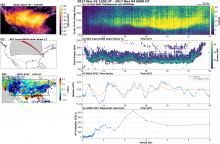Traveling Ionospheric Disturbances Observed by Amateur Radio Published in Geophysical Research Letters
Traveling Ionospheric Disturbances Observed by Amateur Radio Published in Geophysical Research Letters

A team of HamSCI researchers led by Nathaniel Frissell W2NAF just published a new article, First Observations of Large Scale Traveling Ionospheric Disturbances Using Automated Amateur Radio Receiving Networks, in the American Geophysical Union journal Geophysical Research Letters. The article looks at an event from November 3, 2017 to demonstrate how a large-scale disturbance moving through the ionosphere can affect the communications distances on the 14 MHz (20 m) amateur radio band. On this day, a 2.5 hour oscillation could be seen in the minimum distance of 14 MHz contacts recorded by the Reverse Beacon Network (RBN), Weak Signal Propagation Reporter Network (WSPRNet), and PSKReporter. These same oscillations were also seen by the Blackstone, Virginia SuperDARN radar, and in measurements of ionospheric total electron content measured by a global network of fixed-position GPS/GNSS receivers. Using measurements from a radar and ground magnetometers in the auroral zone, it is shown that these disturbances are likely due to ionospheric heating and electron particle precipitation due to auroral activity. This activity can create waves in the neutral atmosphere that can propagate down to the United States region and couple with the ionosphere to create the disturbances. The complete article is available at https://doi.org/10.1029/2022GL097879.
